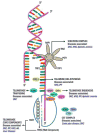Short Telomere Syndromes in Clinical Practice: Bridging Bench and Bedside
- PMID: 29804726
- PMCID: PMC6035054
- DOI: 10.1016/j.mayocp.2018.03.020
Short Telomere Syndromes in Clinical Practice: Bridging Bench and Bedside
Abstract
Short telomere syndromes (STSs) are accelerated aging syndromes often caused by inheritable gene mutations resulting in decreased telomere lengths. Consequently, organ systems with increased cell turnover, such as the skin, bone marrow, lungs, and gastrointestinal tract, are commonly affected. Owing to diverse clinical presentations, STSs pose a diagnostic challenge, with bone marrow failure and idiopathic pulmonary fibrosis being frequent manifestations, occurring in association with gene mutations involving DKC1 (for expansion of gene symbols, use search tool at www.genenames.org), TERT, TERC, and others. Inherited STSs demonstrate genetic anticipation, occurring at an earlier age with more severe manifestations in the affected progeny. Telomere lengths can be assessed in peripheral blood granulocytes and lymphocytes using a sensitive technique called flow cytometry-fluorescence in situ hybridization, and mutational analysis can be performed using next-generation sequencing assays. In approximately 40% of patients with shortened telomere lengths, gene mutations cannot be identified due to the fact that all STS-associated genes have not yet been defined or due to alternative mechanisms of telomere shortening. Danazol, an anabolic steroid, has been associated with hematologic responses in patients with STSs and associated bone marrow failure; however, its reported ability to increase telomerase activity and reduce telomere attrition needs further elucidation. Organ transplant is reserved for patients with end-organ failure and is associated with substantial morbidity and mortality. Herein, we summarize the clinical and laboratory characteristics of STSs and offer a stepwise approach to diagnose and manage complications in affected patients.
Copyright © 2018 Mayo Foundation for Medical Education and Research. Published by Elsevier Inc. All rights reserved.
Conflict of interest statement
Figures



Comment in
-
Telomeres in the Clinic, Not on TV.Mayo Clin Proc. 2018 Jul;93(7):815-817. doi: 10.1016/j.mayocp.2018.05.024. Mayo Clin Proc. 2018. PMID: 29976370 No abstract available.
References
-
- de Lange T. Shelterin: the protein complex that shapes and safeguards human telomeres. Genes. Dev. 2005;19:2100–2110. - PubMed
Publication types
MeSH terms
Grants and funding
LinkOut - more resources
Full Text Sources
Other Literature Sources

